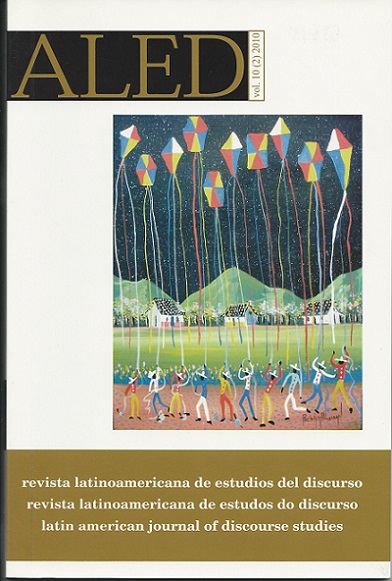Violencia contra mujeres
voz y agencia en noticias de La Nación
Keywords:
physical violence against women. news reports. gender ideologies.Abstract
The present article focuses on the study of the genre consisting of news reports about physical violence by men against women in Argentina. Textual analysis can be seen, following Fairclough (1992, 1995, 2003), as a way of studying language used in texts focusing on socially significant issues. Therefore, in a national sociohistorical context in which sensitivity towards gender issues is increasing daily, the aim of my analysis is to bring to the fore, from a critical perspective (van Dijk, 1991; Fairclough, 2003; Radford, 1992; Eckert y McConnell-Ginet, 2003), the ideological load conveyed in the representations of one Argentine newspaper when it deals with physical violence against women. Such a study actively supports the trend which favors critical media literacy and connects critical discourse studies with an increasing awareness among citizens regarding the constitutive nature of press representations.
Downloads
References
Bengoechea, M. (2006). Hay que evitar la mentalidad que ha creado al maltratador desde la escuela y desde los medios de comunicación. Extraído en mayo de 2008, en http://www.unavarra.es/info/not1894.htm
Cameron, D. (1998). Why Is Language a Feminist Issue? En D. Cameron (Ed.), The Feminist Critique of Language. A Reader (pp. 1-21). Londres y Nueva York: Routledge.
Clark, K. (1998). The Linguistics of Blame. Representations of Women in The Sun’s Reporting of Crimes of Sexual Violence. En D. Cameron (Ed.), The Feminist Critique of Language. A Reader (pp. 183-197). Londres y Nueva York: Routledge.
Decálogo para el tratamiento periodístico de la violencia contra las mujeres (2010). 2da edición. Buenos Aires: Periodistas de Argentina en Red, PAR. Diccionario de estudios de género y feminismos (2009). 2da edición. Buenos Aires: Editorial Biblos.
Eckert, P. (2000). Linguistic variation as social practice. Oxford, Blackwell.
Eckert, P. y McConnell-Ginet, S. (2003). Language and Gender. Cambridge, Nueva York, Port Melbourne, Madrid y Ciudad del Cabo: Cambridge University Press.
Ehrlich, S. (1998). The discursive reconstruction of sexual consent. Discourse & Society, 9(2), 149-171.
Fairclough, N. (1992). Discourse and Social Change. Cambridge y Cambridge, MA: Polity Press.
Fairclough, N. (1995). Critical Discourse Analysis. Londres: Longman.
Fairclough, N. (2003). Analysing Discourse. Textual analysis for social research. Londres y Nueva York: Routledge.
Gómez Calvillo, N. (2008). Gender violence in the press: a critical analysis of three Argentinian newspapers. Tesis de maestría sin publicar. Pittsburgh: Univeristy of Pittsburgh
Jacquinot, G. (1998). O que é um educomunicador? I Congreso Internacional de Comunicación y Educación. Extraído el 15/08/06, en http://www.usp.br/educomradio
Lakoff, R. T. (2004). Annotations to Language and Woman’s Place. En M. Bucholtz (Ed.) Language and Woman’s Place: Text and Commentaries. Revised and Expanded Edition (pp. 103-118). Nueva York: Oxford University Press.
Morduchowicz, R. y Minzi, V. (2003). Claves para pensar el trabajo con la prensa gráfica en la escuela. Extraído el 06/10/ 06, en http://www.comunicacionyeducacion.com/uab
Radford, J. (1992). Introduction. En J. Radford y D. E. H. Russell (eds.), Femicide. The Politics of Woman Killing (pp.3-12). Nueva York, Toronto, Oxford, Singapur y Sydney: Twayne Publishers y Maxwell Macmillan.
Raiter y Zullo (2008). La caja de Pandora. La representación del mundo de los medios. Buenos Aires: Editorial de la Facultad de Filosofía y Letras. Universidad de Buenos Aires.
Steeves, H. L. (1997). Gender Violence and the Press. The St. Kizito Story. Center for International Studies. Ohio University.
Talbot, M. (2003). Gender Stereotypes: Reproduction and Challenge. En J. Holmes & M. Meyerhoff (Eds.), The Handbook of Language and Gender (pp. 468-486). Malden, MA, Oxford, Melbourne, y Berlin: Blackwell Publishing Ltd.
van Dijk, T. A. (1987). Communicating Racism. Ethnic Prejudice in Thought and Talk. Newbury Park y Beverly Hills, California, Londres y Nueva Delhi: Sage Publications, Inc.
van Dijk, T. A. (1988). News as Discourse. Hillsdale, Nueva Jersey: Lawrence Erlbaum Associates, Inc., Publishers.
van Dijk, T.A. (1989). Mediating Racism. The role of the media in the reproduction of racism. En R. Wodak (Ed.), Language, Power and Ideology. Studies in Political Discourse (pp.199-226). Amsterdam y Philadelphia: John Benjamins Publishing Company.
van Dijk, T.A. (1991). Racism in the Press. Londres y New York: Routledge.
Wodak y Meyer (2001). Methods of Critical Discourse Analysis. Londres, California, New Deli, Singapur: Sage Publications Ltd.
Zelizer, B. (1989). Saying as Collective Practice: Quoting and Differential Address in the News. Mouton de Gruyter 9 (4), 369-388.
Downloads
Published
How to Cite
Issue
Section
License

This work is licensed under a Creative Commons Attribution-NonCommercial-NoDerivatives 4.0 International License.
The authors retain the copyright and guarantee RALED the right to be the first publication of the work as well as a Creative Commons Attribution License that allows others to share the work with recognition of authorship and the initial publication in this journal.




